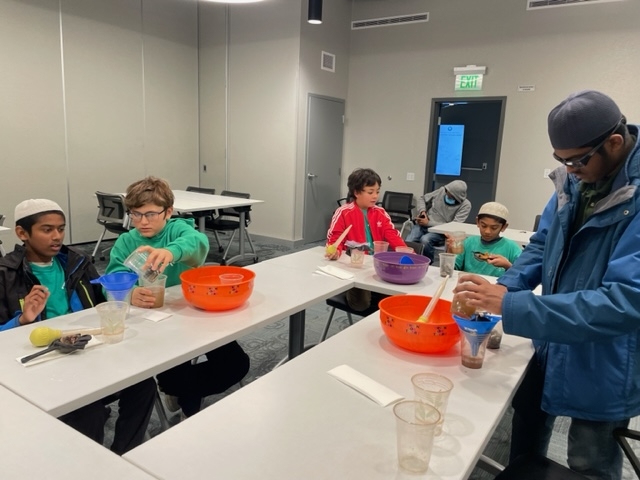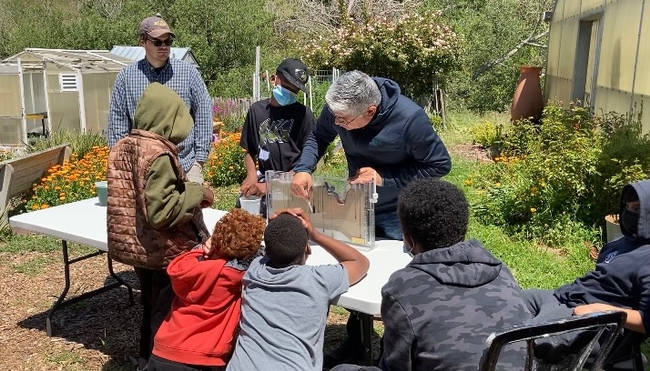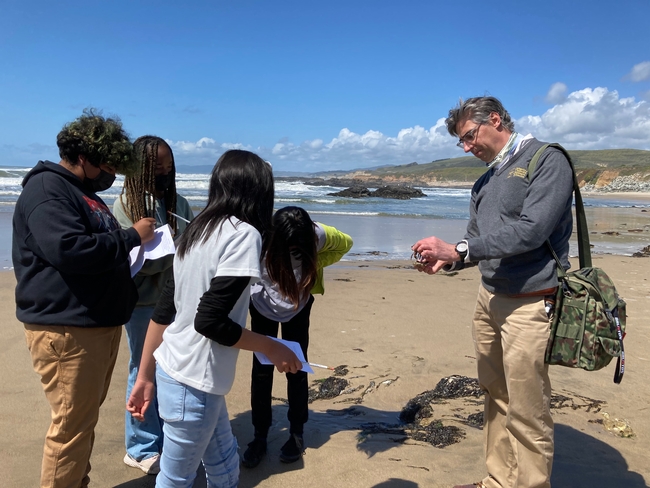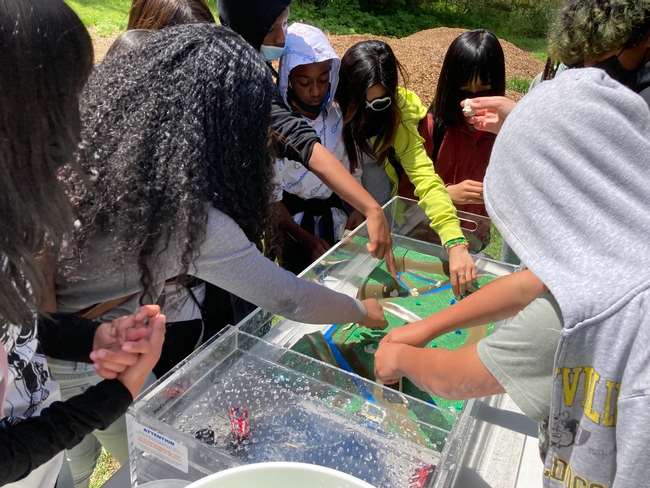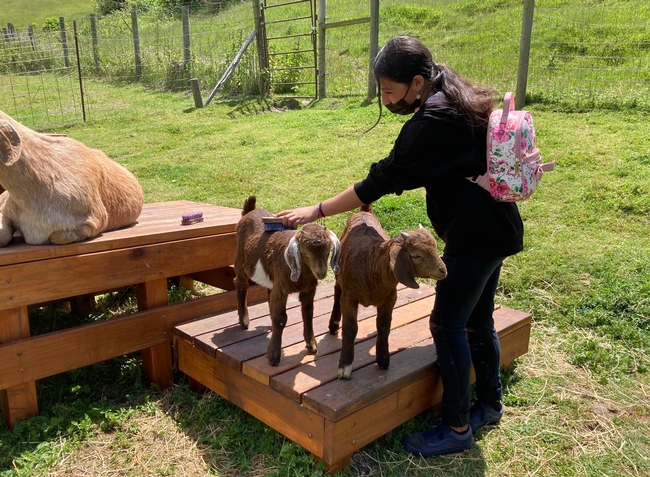Posts Tagged: 4-H
Los Angeles 4-H program cultivates future generation of water stewards
Ibrahim Yaaseen, member of the Palos Verdes Peninsula (PVP) 4-H club, grabs a hard hat and places it on top of his head. He then reaches for a bright orange safety vest and goggles to complete his safety gear outfit before joining the rest of his club members who are dressed the same.
The 4-H Youth Development Program of Los Angeles is already thinking about the future of water management and turned to the West Basin Municipal Water District in El Segundo to gain a deeper understanding of the precious resource we often take for granted.
The University of California 4-H Youth Development Program is managed through local Cooperative Extension offices. Through hands-on learning experiences, 4-H empowers youth to reach their full potential and enables them to build self-esteem, connect with their community and emerge as leaders.
Dee Keese, community club leader for the PVP 4-H club, coordinated an exclusive and interactive tour of West Basin's Edward C. Little Water Recycling Facility for the club's monthly marine biology meeting in December 2022.
Eager to inspire a stronger appreciation for water, Janel Ancayan, the West Basin's education coordinator, challenged the youth to build their own water filters using materials including fabric, a strainer, and a funnel. Since no specific directions were given, the activity challenged each student's science and engineering skills, such as carrying out an investigation, designing a solution, and communicating information with team members.
During the tour, students saw firsthand the impressive equipment and essential staff members that help to produce nearly 40 million gallons of recycled water each day. At the end of the day, students left with a deeper understanding of water resources and felt empowered to do their part to conserve water sources.
“We learned that recycling water helps to conserve our limited water supply and improves the environmental condition of our coastal waters,” said Yaaseen. “We ultimately learned a great deal about how to conserve water for future generations and that water conservation is one of the most important elements in combating climate change.”
Though Keese has volunteered as community club leader for 48 years, this is only the second time she has partnered with the West Basin. “I like to mix it up,” she said. “I'm always looking for community organizations and local businesses to partner with because these are places that the kids will likely interact with since they're nearby.”
Regardless, it's leaders like Keese and programs like 4-H that encourage water stewards like Ancayan. “I'm always so humbled and inspired when teachers make it a point to come out and visit our facility. In Southern California especially, [water] is not something we think about,” Ancayan said.
Even in a drought, water continues to flow from our faucets allowing us to shower, wash dishes or water the lawn. It's no wonder why water conservation is not always top of mind, especially for consumers. Educating the public, and targeting the younger generation, however, is a great start to prepare for the future.
West Basin offers a variety of educational programs that focus on different age groups. Many of them involve hands-on learning like the Teach and Test volunteer program, a partnership with the Surfrider Foundation, where high school students test samples of coastal water for bacteria, and then publicly share their findings to contribute to water quality monitoring in the area.
According to Yaaseen, the time spent with Ancayan at the West Basin was “one-of-a-kind” and provided a “golden opportunity” to learn why water recycling facilities are important. Ancayan hopes that her time spent with students ultimately influences them to consider a career in water.
“It's not a glamorous job but I'm really passionate about the next generation of water workers,” she said. “I hope that once they see the engineering, the excitement of these scientists that work in our laboratory and everything in between, that they start to think about water as a future career path.”
For those interested in joining 4-H, visit https://4h.ucanr.edu/Members/
To read this story in Spanish, please visit:
Programas 4-H de Los Ángeles forman a la futura generación de administradores de los recursos hídricos
https://ucanr.edu/blogs/blogcore/postdetail.cfm?postnum=57063
Incredible Memories of 'The Honey Bee Guru'
It was incredible. The Celebration of Life and Legacy of UC Cooperative Extension apiculturist emeritus Eric Mussen, held Aug. 28 in...
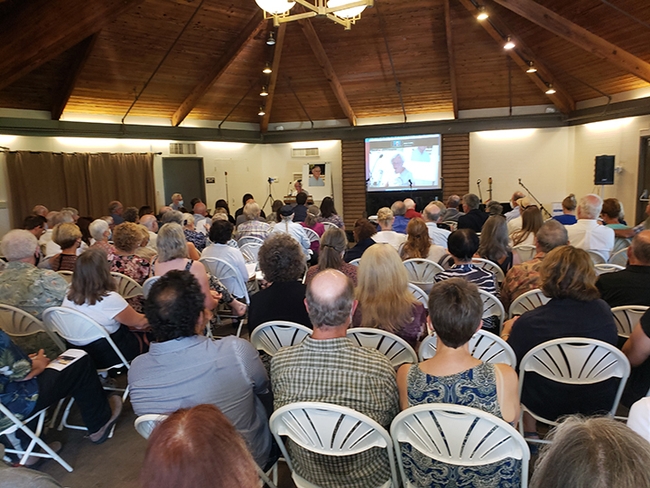
A capacity crowd attended the memorial for UC Extension apiculturist Eric Mussen in the Putah Creek Lodge, UC Davis. (Photo by Tabatha Yang)
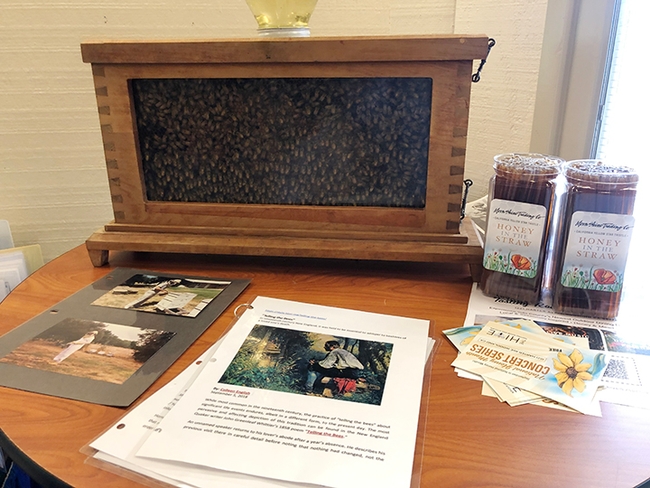
A bee observation hive at the Eric Mussen memorial commemorated his love of honey bees. (Photo by Kathy Keatley Garvey)
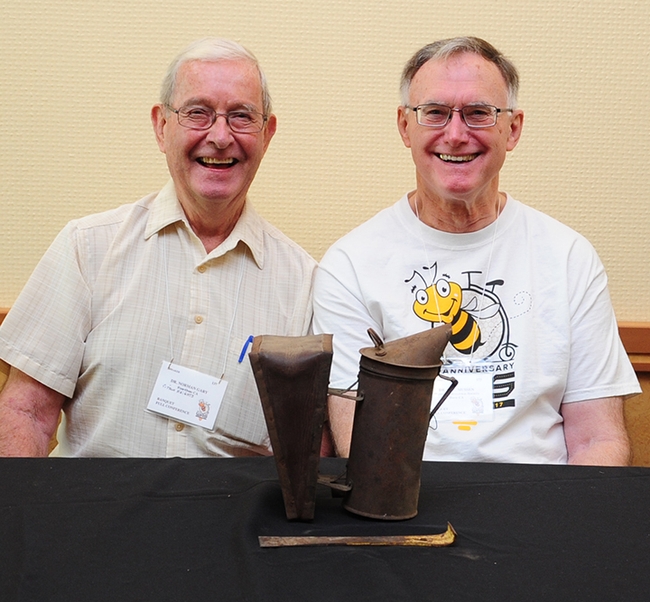
Extension apiculturist Eric Mussen (right) and Norm Gary, UC Davis emeritus professor of entomology, at the Western Apicultural Society meeting at UC Davis in 2014. (Photo by Kathy Keatley Garvey)
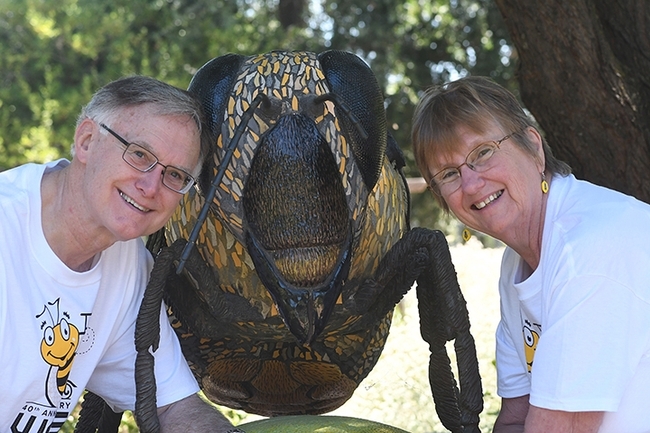
Eric and Helen Mussen in front of the sculpture, Miss Bee Haven, at the UC Davis Bee Haven in 2014. (Photo by Kathy Keatley Garvey)
Meet Ettamarie Peterson: Sonoma's Queen Bee and 4-H Beekeeping Queen
When 4-H beekeeping project leader Ettamarie Peterson of the Liberty 4-H Club, Petaluma, meets with her youth group at the beginning of the 4-H year,...
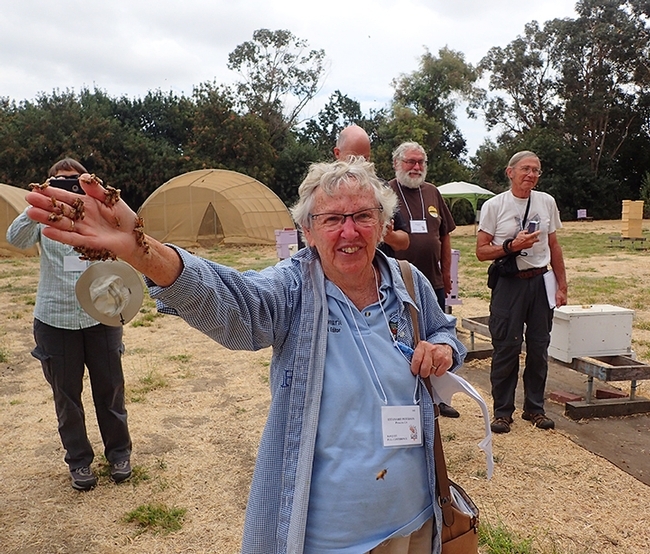
Petaluma beekeeper Ettamarie Peterson holds some newly emerged bees at a Randy Oliver demonstration at the 2007 Western Apicultural Society tour of the Harry H. Laidlaw Jr. Honey Bee Research Facility at UC Davis. (Photo by Kathy Keatley Garvey)
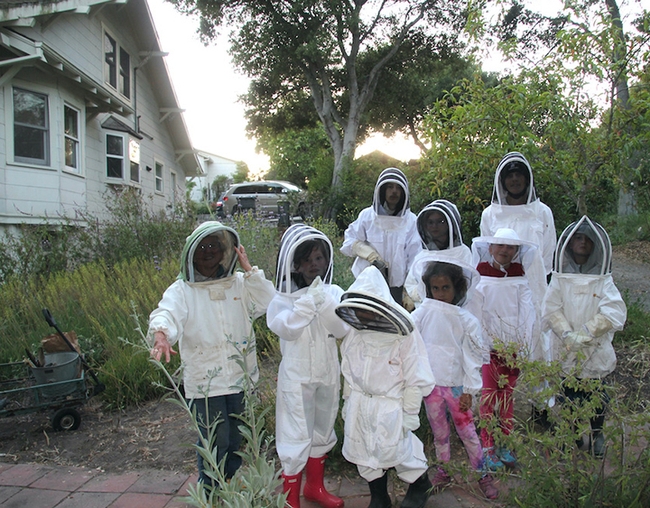
Veteran 4-H beekeeping project leader Ettamarie Peterson (far left) with some of her 4-H beekeepers from the Liberty 4-H Club, Petaluma.
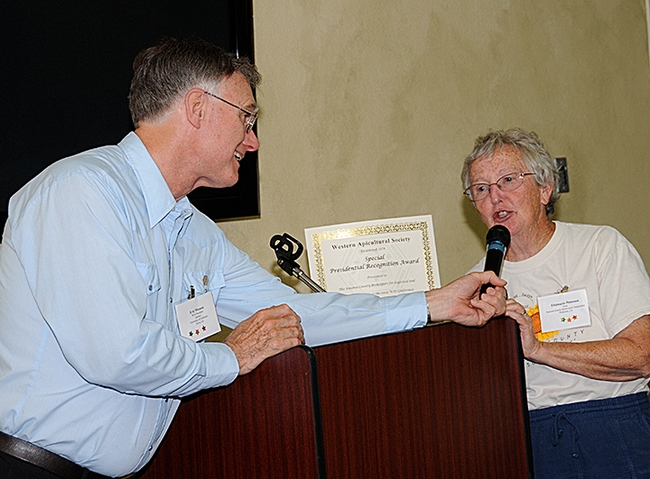
Extension apiculturist Eric Mussen of the UC Davis Department of Entomology and Nematology and a co-founder and six-term president of the Western Apicultural Society (WAS) hands Ettamarie Peterson an award at the 2009 society meeting. Mussen died June 3, 2022 of cancer. (Photo by Kathy Keatley Garvey)
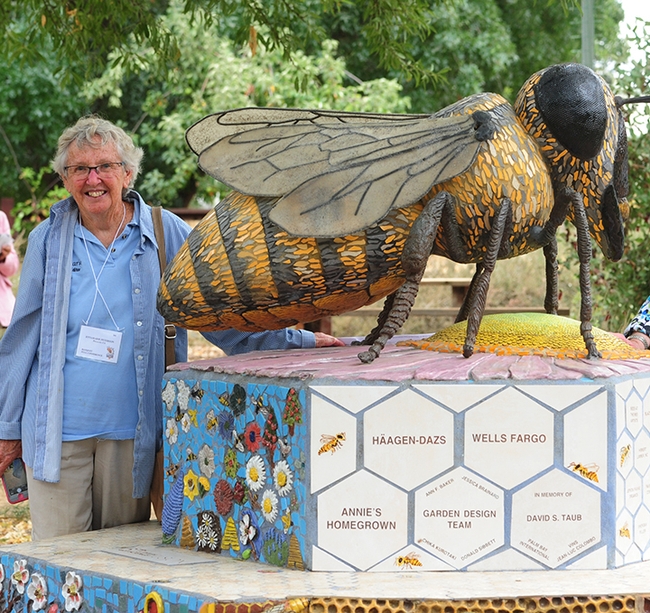
Ettamarie Peterson, known as the Sonoma County Queen Bee, stands by the bee sculpture, Miss Bee Haven, that anchors the UC Davis Bee Haven. (2007 Photo by Kathy Keatley Garvey)
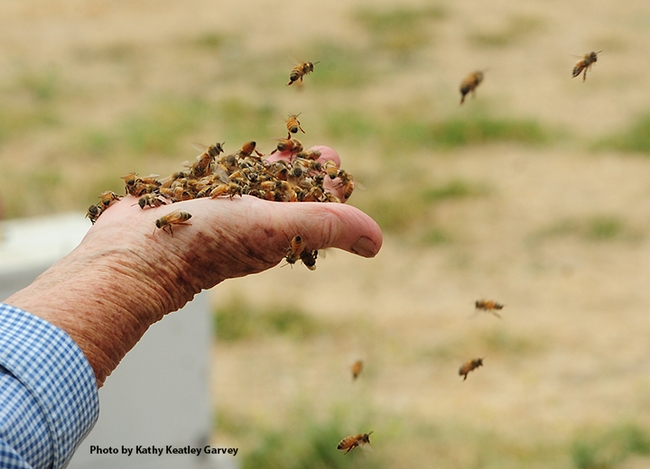
"Bee mine!" Beekeeper Ettamarie Peterson holds nurse bees at the Harry H. Laidlaw Jr. Honey Bee Research Facility, UC Davis, in 2007. (Photo by Kathy Keatley Garvey)
Elementary school students explore water’s role in life
“I found so many things; I found a hermit crab, a starfish, a sea anemone,” exclaimed a Cherryland Elementary School student, his voice trailing off as he ventured back to the tide pools to explore more. The fifth grader from Hayward was participating in a 4-H Water Wizards course during a UC Cooperative Extension-sponsored field trip to Pescadero State Beach in San Mateo County.
In May, University of California Cooperative Extension bused 120 fifth and sixth graders from Hayward's Cherryland Elementary School – where the student population is 86% Hispanic and 6% Black – to UC Elkus Ranch Environmental Education Center in Half Moon Bay to learn about different aspects of water.
“These Black and Brown grade-school children are learning about water from people who look like them and speak like them,” said Frank McPherson, director of UC Cooperative Extension in the Bay Area, who is leading the launch of 4-H Water Wizards in the Bay Area. “As the students visit each experiential learning station and the ocean, the instructors are asking them thought-provoking questions like ‘How do you think the water will move through the landscape?' and ‘What do you see in the water?'”
4-H Water Wizards is designed to give socially disadvantaged students of color opportunities to meet diverse scientists and imagine career possibilities in science, technology, education and math, or STEM.
“I'm really happy that we were invited by the UC Agriculture and Natural Resources to come out to Elkus Ranch so my kids can participate in an opportunity to engage in not only the fun that's out here, but also the animals,” said JoDana Campbell, Ed.D., Cherryland Elementary fifth grade teacher. “I was also really impressed with the number of scientists that are actually here on this ranch that were able to work with my kids at the varying stations about this idea of water and how we utilize water. Not only in California, but just generally in the world: how does water work?”
This spring UC Cooperative Extension educator Tanya Henderson, in collaboration with Cherryland Elementary School teachers and Nancy Wright, Hayward Unified School District elementary science partner teacher, introduced four classes at Cherryland Elementary to the 11-week 4-H Water Wizards curriculum. One of the classes has had a series of substitute teachers all year, making Henderson the most consistent instructor for a few weeks.
One teacher wrote to McPherson expressing her appreciation for the teaching assistance, saying, “I am especially grateful for Ms. Tanya, our teacher. Having another adult to co-teach is invaluable to say the least. Her teaching methods and care to engage students is remarkable.”
The field trip to Elkus Ranch and the ocean expanded on the classroom water lessons.
At the first of four learning stations, UC Davis graduate students used an Enviroscape model to show the Cherryland students how rainwater runoff moves through a community. The youngsters placed plastic houses on the landscape and fashioned clay into walls and dams to protect their houses from flood waters. After observing simulated rain on their community, the students discussed the results.
“The dam made it worse!” said one student.
“Maybe we should remove the dam,” said Cassie Bonfil, a UC Davis graduate student. “The water naturally wants to flow to the river. We're blocking it from going to the river, forcing it to go up into the houses.”
Using sand between sheets of plexiglass as a window into a cross section of soil and an aquifer, UC Cooperative Extension specialist Samuel Sandoval Solis led the students in demonstrating the movement of water when it filters through soil into the ground and when water is pumped from wells.
In the Elkus Ranch children's garden, Henderson encouraged students to touch and smell plants that could be used to make soaps, salves and other products.
The students also interacted with the sheep, goats, rabbits, chickens and other livestock that live at Elkus Ranch. Beth Loof, 4-H youth community educator, discussed the role of animals in agriculture as well as their relationships to soil, water and food systems.
“I just think it's a really good opportunity to engage inner city youth in something where they do not have an opportunity to engage in normally,” said Campbell, the Cherryland teacher. “This ranch is an awesome opportunity to come out to learn, there's a great museum up the way. My kids have been very excited about the whole process.”
The curriculum and educator are funded by a grant from USDA National Institute or Food and Agriculture, but to hire more buses to transport more schoolchildren to Elkus Ranch for the outdoor experience, McPherson is raising money. Donations to the Bay Area 4-H Water Wizards project can be made at https://donate.ucanr.edu/?program=California 4-H&county=Alameda.
Bees, Butterflies and Beetles and More at Dixon May Fair
Bees, butterflies and beetles will be well represented at the 145th annual Dixon May Fair, which opens Thursday, May 5 for a four-day run (May 5-8)...
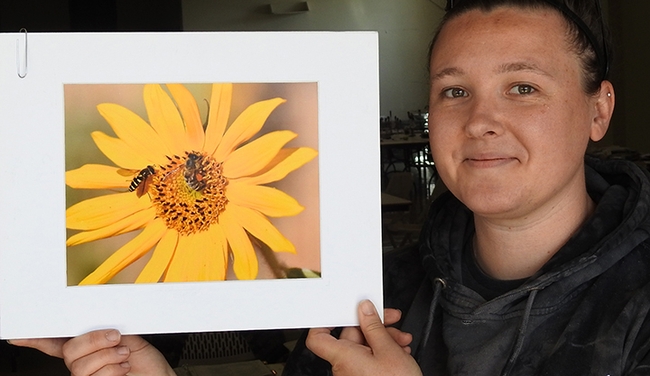
Marine biologist Leta Myers, who clerked at the Dixon May Fair judging, holds a photo by Vaca Valley 4-H'er Matthew Agbayani. It depicts a honey bee and a syrphid fly on a sunflower. (Photo by Kathy Keatley Garvey)
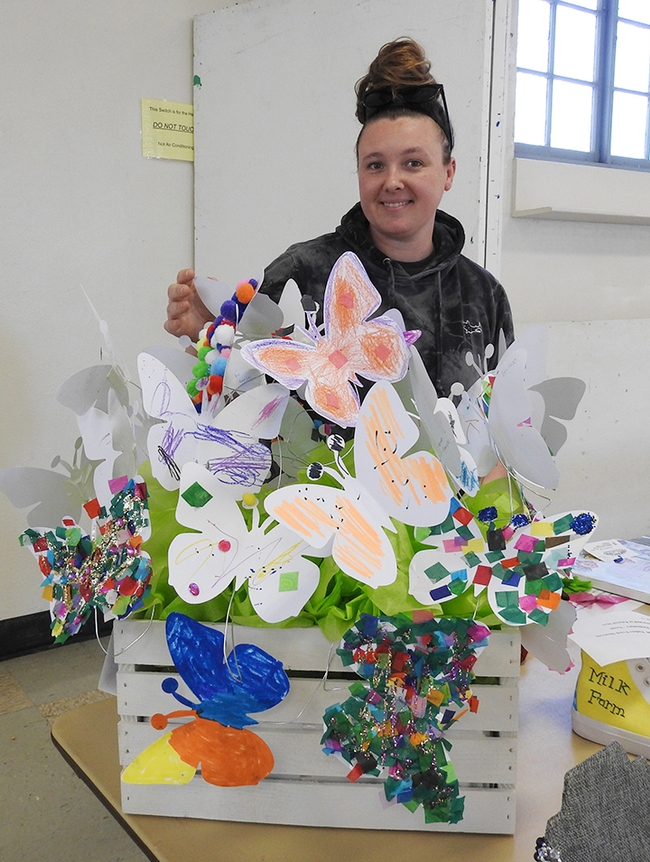
Leta Myers admires this entry in the Dixon May Fair. It is by a Tremont Elementary School classroom and is on display in the Youth Building (Denverton Hall). Myers, a marine biologist, and her husband, in the military, just returned from Japan and their next move is to Washington state. (Photo by Kathy Keatley Garvey)


